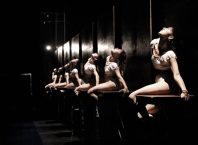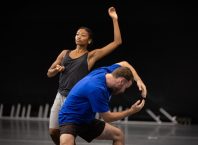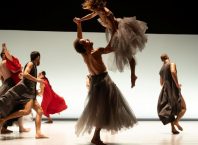It’s hard to go wrong with a peanut butter sandwich, almost anyone can make one, there’s not a lot of uncertainty about it. Peanut butter is usually involved. On the eating side of the equation, it’s very straightforward: either you like ’em or you don’t. Now, don’t be offended when I say that classical ballet is a lot like a peanut butter sandwich: practitioners run the gamut from sorry to superlative, but the audience has a good idea of what to expect. Classical dance and other forms such as jazz or folk dance, create a composition based on movement, sound, and imagery, to convey emotion, tell a story, or at the more abstract end of the spectrum give the viewer an experience. There is also the expectation of technical proficiency and aesthetic pleasure, and these are the criteria by which one usually evaluates the experience.
Contemporary dance, on the other hand, is a lot more experimental – think for example, of molecular cuisine (yes, you really want to watch this fun deviation on PBJ). Watching a performance of contemporary dance is like going to a chef’s restaurant with a surprise fixed menu: you often have no idea what to expect, and even once you’ve seen and tasted the food, you may have a hard time figuring out exactly what it is you’ve experienced. It may take several “tastings” before you decide whether you like it or not.
What do I look for in contemporary dance? I am a demanding viewer, I want it all to be right there, where I can see, hear and feel it. Something beyond or other than words, that communicates to me through my senses, and arouses associations, feelings, and thoughts.
Curtain Up is a showcase for independent choreographers, the many performances are a bit like a tasting menu of small dishes prepared by several chefs. This year’s table, under the artistic direction of Itzik Giuli, was abundant, and while I didn’t have a chance to taste it all, but I’ll share my impressions with you.
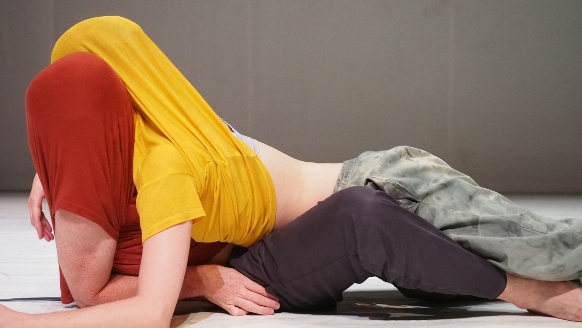
I’ll Be Right Back, choreographed by Iris Erez, and performed by Ayala Frenkel and Ofir Yudilevitch is a funny, tender work that examines myriad relationships – stage and life, self and other, public and private, love and work – with a movement language that is engaging and imaginative. It doesn’t hurt that Johann Sebastian Bach’s Goldberg Variations (I believe as interpreted by Glenn Gould) opens this piece as the audience gazes at an empty stage. In that stillness between one note and another, there is an invitation to look at the all-white stage and wonder about this platform and its meaning. Something happens when you place a person or object onstage (whether the stage is physical or virtual), it changes, acquires a different significance.
After an interval, the male dancer, Ofir, enters the auditorium and walks up the stairs to the stage. The female dancer, Ayala, follows soon after from the other side. Both are dressed in casual street clothes, T shirt and loose pants. As they move individually on the wide stage, each in a different physical place, they engage in the everyday conversation of couples: What are you doing today? Want to meet later? Hummus? The physical distance and difference in movement between the dancers heightens the humor and recognition of this desire and effort to maintain intimacy in a crowded world. In movement and text, Ofir and Ayala both deliver a compelling performance that instantly draws one in, together and apart they are wonderful to watch.
As one who is familiar with Erez’s previous works, often focusing on themes of borders and difference, it was interesting to recognize signature movement, yet discern a difference. The movement language in this work that is so much about relationships is rounder, softer, with more curves and spirals, more room to breathe. Visuals by Daniel Landau and an excellent soundtrack augment the work and allow associations to reverberate. The juxtaposition of “dance” intervals, when this couple is simply dancing together as any couple might at a party, with a diverse and imaginative array of bodies coming together in different combinations of connection and mis-connection conveys the complexities of relationships in a way that is at once very entertaining, yet nuanced and replete with associations. There are many poignant moments. One recurring motif is the physical image of searching for someone who is right there, yet somehow unseen or hiding. Whether a headstand meets a back bend, one is riding on the other’s back, or they embrace head to head, one cannot help but feel the tensions, desires and absurdity of it all.
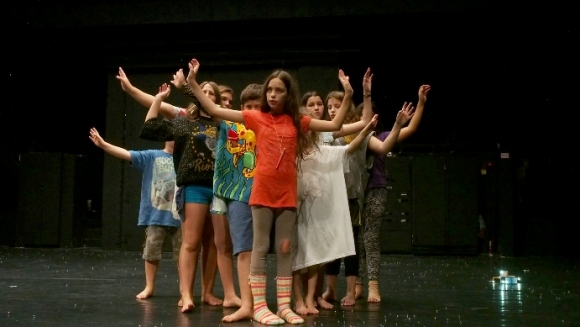
Reflecting on the effect of the stage take me to Shani Granot and Nevo Romano’s That What. It’s a wonderful experiment. Placing a group of children (8 children, ages roughly 10 – 13) onstage with a fun assortment of objects – cell phones, shoes, bubbles and the marble sculpture of a cherub’s head – inevitably arouses curiosity and wonder. Just looking at children as they go about their ordinary daily activities is a never-ending source of emotion and contemplation. Yet I did not feel that this work had really made it past the ‘lab’ stage, in other words, it lacked the sense of a fully formed work that provides insight. Kids are awesome, but I knew that already.
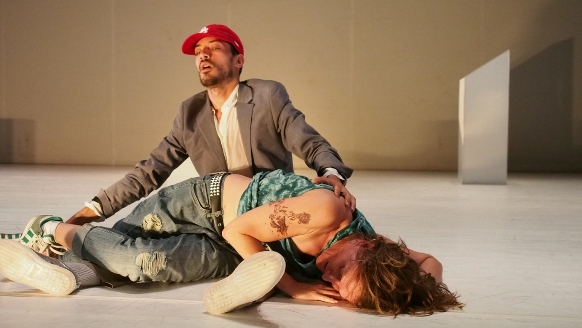
How much does the appreciation of a work depend on prior knowledge or experience? Ido Feder’s The Act opened with the very talented dancer Shahar Binyamini standing in front of the curtain making signature Nijinsky moves with eloquence, panache and perhaps a bit of humor. As someone in a nearby row whispered to their companion “Nijinsky,” I wondered whether the dance reference was essential to one’s understanding. In this case, I think the contrast and relationship between Binyamini’s ‘dancer’ character and Tamar Shelef’s ‘SK8RGRRL’ character was so immediate, visual, and physical that anyone could get it, regardless of background. I loved the soundtrack: Tamer Nafar (DAM), Murad Abu Ahmad and Yuval Goren made the subtext shout out: street, sex and raging rebellion. Not so sure how I feel about the work as a whole. I get it, I’m intrigued, yet I felt that it ends up meandering and the energy dissipates.
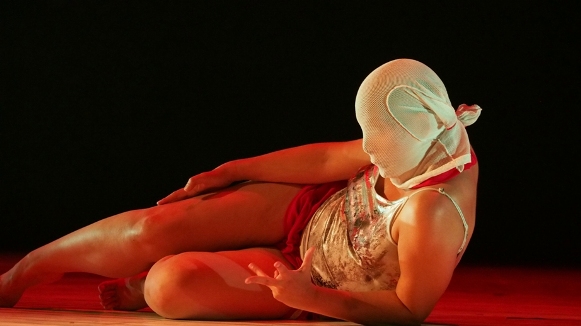
Other works that had clarity, yet did not come together for me as a complete whole were Bugs, a solo by Merav Cohen, and Blue Marks Hologram by Bosmat Nusan, performed by Shani Garfinkel and Ayala Frenkel. Bugs was clearly dealing with issues of self and identity, yet did not draw me in. Nusan’s work reflected certain tensions between the two performers, and was aesthetically pleasing, yet I felt it lacked that “something” that would pull it all together.
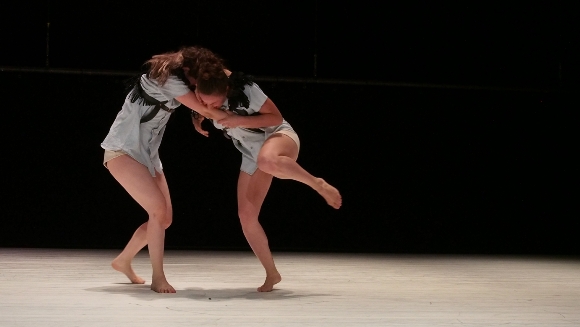
Found Objects by Tami Lebovits had me pondering the ever-blurring border between performance art and dance. There was one section I found evocative with the dancers in long, white gowns posing and moving beside a larger-than-life black and white portrait of Sigmund Freud. Prior knowledge must come into play here, although I think that the mis-en-scene conveyed the essential information effectively. Yet here too, despite amusing critique of modern consciousness, I felt that the work as a whole lacked coherence.
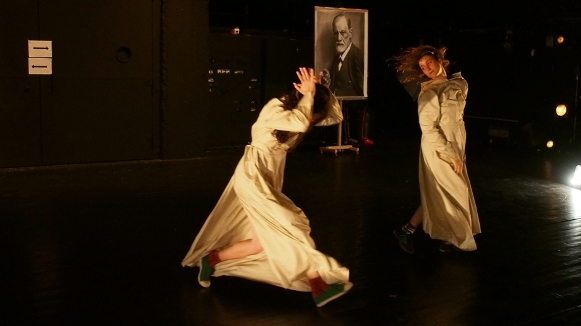
Unfortunately, difficulties of scheduling and availability of tickets meant that I did not see everything, yet the overall experience has made its impression and raised some questions in my mind. Should Curtain Up be perceived as a showcase of performances, or as a showcase of works in progress? The latter, feels a more accurate description for most of the works I saw. Another, more general, question that was ever-present as I watched the works of these up and coming Israeli choreographers: is there a tendency (at least among the emerging generation of choreographers) for contemporary dance in Israel to become more conceptual, with the ideas and text occupying a place equal to the performance itself?

